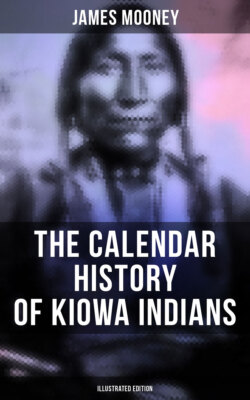Читать книгу The Calendar History of Kiowa Indians (Illustrated Edition) - James Mooney - Страница 16
На сайте Литреса книга снята с продажи.
Tribal Sign
ОглавлениеTable of Contents
To make the sign for "Kiowa" in the sign language of the plains tribes, the right hand is held close to the right cheek, with back down, fingers touching and slightly curved, and the hand moved in a rotary motion from the wrist. According to the Kiowa this sign had its origin in an old custom of their warriors, who formerly cut the hair from the right side of the head, on a line with the base of the ear, in order better to display the ear pendants, while allowing it to grow to full length on the left side, so as to be braided and wrapped with otter skin after the common fashion of the southern plains tribes. This was in addition to the ordinary small scalplock hanging down behind. This style of wearing the hair, although now nearly obsolete from long association with tribes of different habit, is still occasionally seen. It is shown in the picture of the chief Big-bow, taken in 1870 (figure 43).
Dodge thus correctly explains the sign: "Kiowa—The open palm, held bowl-shaped, to right of and beside the face, is passed round and round in a circle. Supposed to indicate the peculiarity of these Indians in cutting the hair of the right side of the head" (Dodge, 2).
The sign has no connection with the idea of "rattle-brain," "crazy head," "crazy knife," "drinking water," or "prairie people rising up," as has been variously stated; neither is the sign ever properly made on the left side. Such misconceptions have arisen from the careless making of the sign by persons ignorant of its true meaning. The Cheyenne claim that it refers to a former Kiowa custom of painting a stripe across the upper lip and cheeks. This is probably only an attempt to explain the name Witapätu, q.v., without any basis in fact, for, had such a custom existed, it would have been indicated by drawing the finger across the face. Moreover, in a series of forty figures painted for the author by Kiowa Indians to illustrate their ancient styles of war paint, not one is thus depicted.
